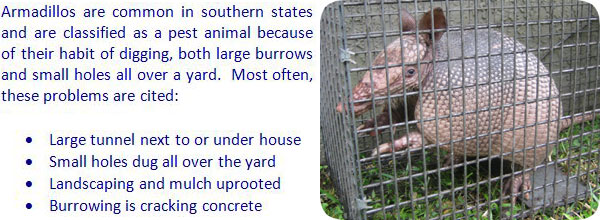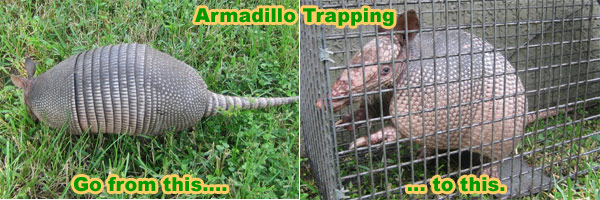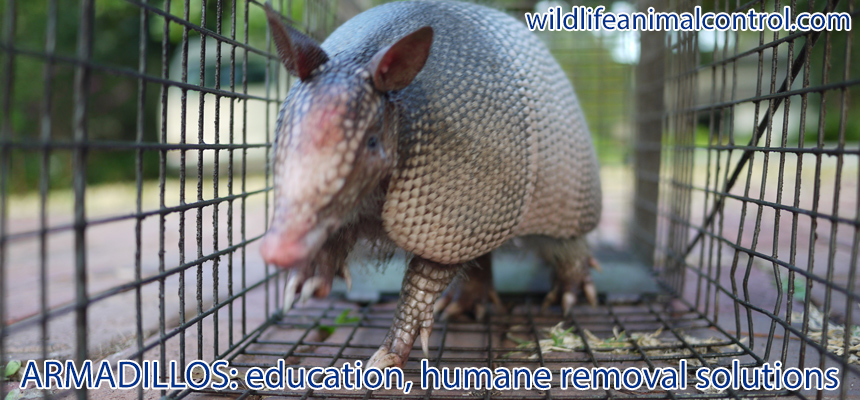- info@wildlifeanimalcontrol.com
Call us for help in your town
Wildlife Control Education
How To Get Rid Of Armadillos

We perform armadillo removal in over 1700 USA locations - serving the whole USA. It is my goal to educate the public about armadillos and other wildlife, and provide tips for safe, effective, and responsible wildlife removal.
HUMANE HINTS: In some cases you can resolve a armadillo problem without trapping the animal - for example, you can install fencing around a property you don't
want dug up. If you use a cage trap, be sure to set it in the shade and relocate
the armadillo as soon as possible. Never attempt to poison armadillos. Unfortunately, there are no effective or registered armadillo repellents. Read below for how-to hints.
Summary of Step-By-Step Instructions for Armadillo removal:
1) Purchase large cage traps - rated raccoon size, usually about 10" x 12" x 30" or so.
2) No bait is effective - set traps in areas of high armadillo activity, on trails or even on top of escape burrows. Make sure traps are scent-free and flush to the ground, line the bottom of the trap with dirt and debris, and set in the shade.
3) Relocate any trapped armadillo at least 5 miles from capture site.
4) If you have armadillo living under a deck, shed, or other structure, install an exclusion barrier - steel mesh around the perimeter, and down at least 12 into the ground, with bottom of mesh sloping outward.
Need armadillo removal in your hometown? We service over 500 USA locations! Click here to hire us in your town and check prices - updated for year 2020.
Armadillos are certainly one of the most resilient and well protected creatures in the animal world, and this natural amour has made them one of the most successful animals in North America. They will not normally make their burrows in gardens unless they are quite near to some trees, but they will often cover a lot of distance during their nocturnal wanderings, which can take them to gardens near their burrow. Because of this there are a number of problems with catching and removing the animals.
Catching An Armadillo
The best way to get rid of an armadillo is to trap it and remove it away from your area. There are a number of live traps on the market, and those that are designed for raccoons or skunks will be about the right size, approximately 10" x 12" x 30" or so. Some people will bait their traps with fruit, while others who are particularly aiming for armadillos will use earthworms in an old stocking as bait. However, no bait is necessary or even helpful! The most important thing to do though is to ensure that the trap is in the right place, as armadillos will often walk around the edges of a garden, and will stay closer to areas with cover. Set the trap at edges, on armadillo paths, or better yet, right on top of an armadillo burrow! Read more detailed info about armadillo trapping - analysis and methods for how to trap, bait, laws, and more.

Once this has been done and the armadillo has been caught, it is best to take it away at least a few miles before releasing it back into the wild. There are a number of other issues to consider with armadillos, because many states will only allow licensed individuals to catch and release them. Because the armadillo is not a native species to the majority of areas, it is best to check state laws before catching them, or to hire a professional to deal with the animal for you.
Steps To Take After Armadillo Problems
The problems that armadillos cause can be quite significant, so if you are having regular problems with the animals then there can be a number of steps you can take. One of the most important things you can do is to ensure that your fences are planted under the ground, and using a foot or two of steel wire fence will prevent the armadillos from digging under your existing fence. There are also a number of landscaping methods you can use to reduce the attractiveness of your garden to armadillos.
If you know where the armadillo has been burrowing, then filling in that burrow will be wise to prevent other armadillos from moving into that hole. Armadillos are good scavengers, so keeping any pet food indoors and trying to keep garbage sealed if possible to prevent the odors from attracting them. Making sure the lids on garbage cans cannot be easily removed will also help. Read more information about how to keep armadillos away - prevention techniques.
Summary
Armadillos are very tough and resilient animals, and being an invasive species in North America they have been very successful. Having a well armored hide they are very good at being bad prey for predators, and this lack of predators also has another effect. Because the majority of repellents are based on predator urine, this means that there really isn't any effective repellent that will keep armadillos from your garden and property.
Some people will actually like having armadillos in the area as they do eat insects and other pests, but can quickly become a pest themselves. Removing them is really the only option, and for those who aren't confident to do it themselves most areas will have a wildlife removal expert who can take of the problem for you and get rid of the armadillo.

More in-detail how-to armadillo removal articles:
Information about how to kill an armadillo - with poison or other methods.
Information about how to catch an armadillo - by hand or with special snares.
Information about armadillo repellent - analysis of types and effectiveness.
Nine Banded Armadillo Appearance: Living up to twenty years, the nine banded armadillo is the most widespread of its species, inhabiting much of North and South America. This small mammal weighs about thirteen pounds and is covered in a hard armor. The name ‘nine banded armadillo' derives from the fact that the bony plate covering the animal is comprised of nine different sections. Other species of armadillos are also named based on the number of interlocking plates on their bodies. These plates are known as scutes. The armadillo is oblong with a triangular head and close-set ears. It is usually a light tan in color, though a variety of browns and grays within the scutes contribute to the overall hue.
Nine Banded Armadillo Habitat and Behavior: Preferring loose soil, which is conducive to digging, the nine banded armadillo lives in areas of grasslands and prairies, as well as mature forests. It is not an animal that tolerates extreme temperature variances, so it is not found in areas with long, cold winters. The armadillo has low reserves of fat and is not able to hibernate, two key necessities for an insectivore to survive in freezing temperatures. Currently, the armadillo is present predominantly in the southwestern and southern states.
The nine banded armadillo is not able to curl completely into a ball like its smaller cousin, the three banded armadillo. Instead, when frightened, the nine banded armadillo will leapt into the air in excess of three feet. This habit has made the animals particularly dangerous to motorists, especially since the nocturnal nature of the animals makes them active when visibility is low. While curling into a ball is the most recognizable defense, and one this particular species is incapable of, the ability to burrow aids this small creature in defense. When frightened, the armadillo will dig a hole and wedge itself within. A predator will eventually give up when the armor cannot be breached and the animal cannot be removed from the burrow. In their territories, nine banded armadillos create extensive burrow tracks with as many as twelve intersecting tunnels. Females and males are both solitary, though male territories will overlap as many as three female claims.
Interestingly enough, armadillos were often hunted during the Great Depression as an alternative meat source similar to pork.
Nine Banded Armadillo Diet: A delicate sense of smell is the most important tool for the nine banded armadillo, allowing the animal to detect food sources deep within the soil. Insects and invertebrates make up the majority of the armadillo's diet, though they will eat carrion and small amphibians if need be. A sticky tongue helps the animal quickly collect any colonies of insects located in the dirt. Speaking of diet, do armadillos eat turtle eggs?
Nine Banded Armadillo Nuisance Concerns: Because most of the components of an armadillo's diet live in the soil, this makes the creatures destructive when they cross into human yards. An armadillo can quickly tear apart large areas of topsoil and can create a burrow in less than a day. Burrows near or under buildings can compromise the integrity of the structure. Constant foraging will damage root systems of shrubs, bushes, and small trees and can ruin landscaping. Abandoned armadillo nests are also home to other wildlife such as skunk and snakes.
Nine Banded Armadillo Diseases: Armadillos are one of the only animals able to carry and spread the human disease known as Leprosy. This disease is usually transmitted by eating undercooked armadillo meat, though transmission through a scratch or bite is possible. Rabies is very uncommon in armadillos due to their naturally low body temperature, but infection is still possible. Salmonella, common bacteria that affect the gastrointestinal system, can be spread through armadillo feces.
This site is intended to provide armadillo education and information on how to get rid Of armadillos, so that you can make an informed decision if you need to deal with an armadillo problem. This site provides many armadillo control articles and strategies, if you wish to attempt to solve the problem yourself. If you are unable to do so, which is likely with many cases of armadillo removal, please go to the home page and click the USA map, where I have wildlife removal experts listed in over 500 cites and towns, who can properly help you with your nuisance armadillo.
Read more about armadillos in my educational articles - like my best advice on how to use One-way exclusion funnels to remove armadillos. Learn about the Armadillo diet, the diseases armadillos carry, and what you should do with an armadillo after you Catch it.

















